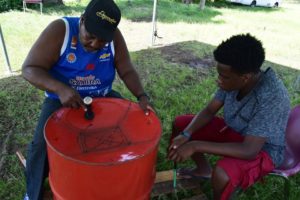A Very Successful Pan Tuning Workshop for young people
 The Training, Promotion & Development Department of the Cultural Development Foundation (CDF) hosted a Pan Tuning Workshop which was generously funded by the SLHTA’s Tourism Enhancement Fund. The two week long training workshop was held from August 10th to 21st, 2015, from 9:30 am – 3:30 pm each day at the Courts Babonneau Pan Yard in Grande Riviere, Gros Islet.
The Training, Promotion & Development Department of the Cultural Development Foundation (CDF) hosted a Pan Tuning Workshop which was generously funded by the SLHTA’s Tourism Enhancement Fund. The two week long training workshop was held from August 10th to 21st, 2015, from 9:30 am – 3:30 pm each day at the Courts Babonneau Pan Yard in Grande Riviere, Gros Islet.
The Pan Tuning Workshop provided practical skills and valuable knowledge as a strategy to actively build our base of skilled leaders and Steel Pan professionals in Saint Lucia.
According to the CDF, “The training and development aspect of Steel Pan is almost as important as the entertainment itself. By taking an integrated approach to ensure a long-term future for quality steel pan music, the Steel Pan Groups can look forward to notable successes in the future.”
The Pan Tuning Workshop was facilitated by Mr. Gabriel Robley of Trinidad. Gabriel has an education in advanced steel pan Tuning. He has experience as a pan tuner in Trinidad, Grenada, Cayman Islands, and Jamaica and is also a Pan Educator who conducts workshops in history and playing of steel pan instruments.
About Pan Tuning:
Tuning a pan or set of pans is a complex process that takes many hours of work, generally spread over a period of at least two days. The first step is to obtain 55 gallon barrels. Pan instruments vary in terms of the number of barrels required, the number of notes on the playing surface, the depth of this surface when hammered into a concave shape, and the length of the “skirt” (the sides of the pan).
Though each pan instrument has its unique features, the basic tuning principles are the same. Once obtained, the barrel is turned upside down, with the top resting on the ground. The bottom of the pan is sunk inward. Once the surface has begun to assume a concave shape, a pencil and ruler are used to make some preliminary markings of individual sections, each of which will become a note.
The next step of the tuning process is to “groove” the individual note sections with a 24-ounce hammer and a nail punch with a blunted point. When all of the sections have been grooved, the pan is ready to be cut.
